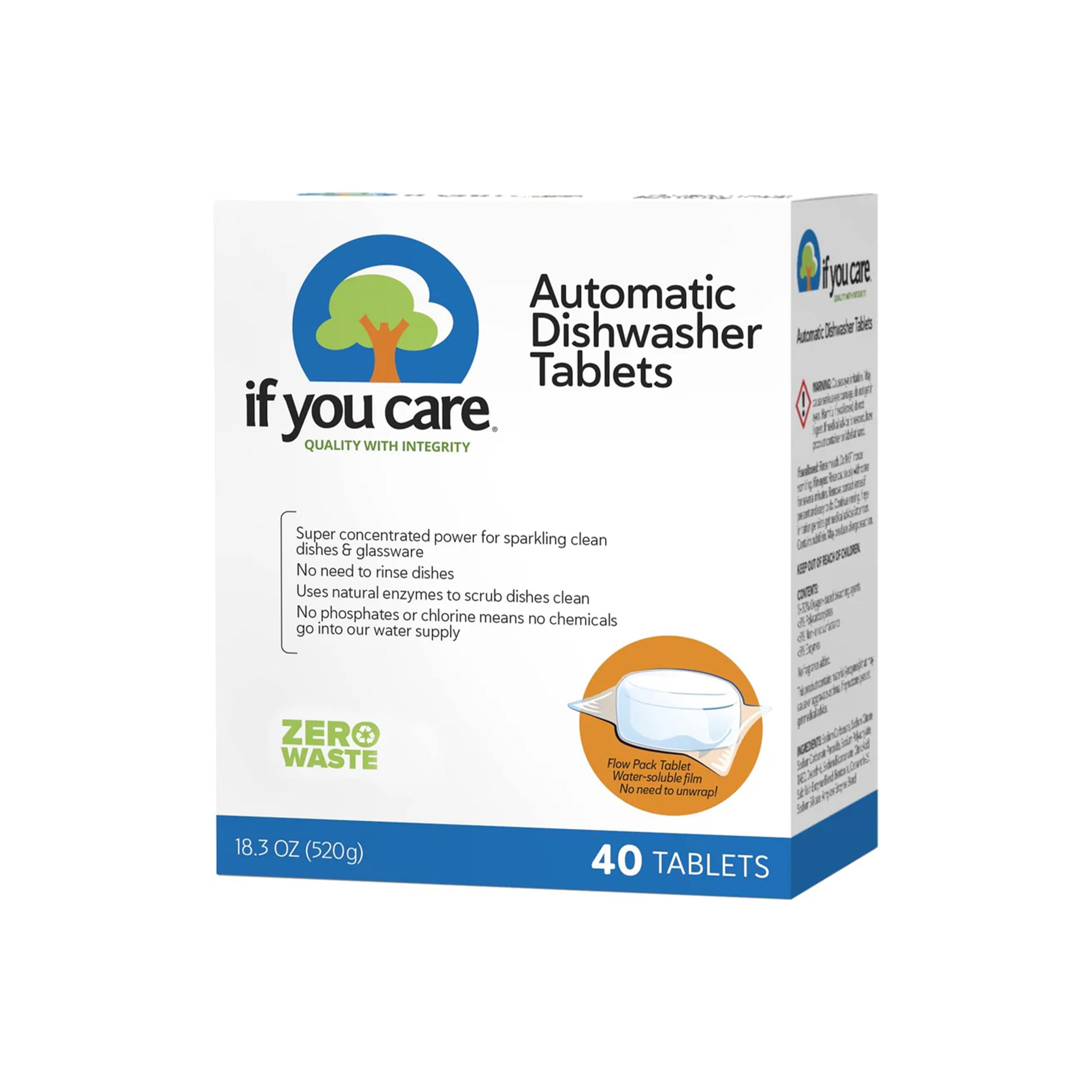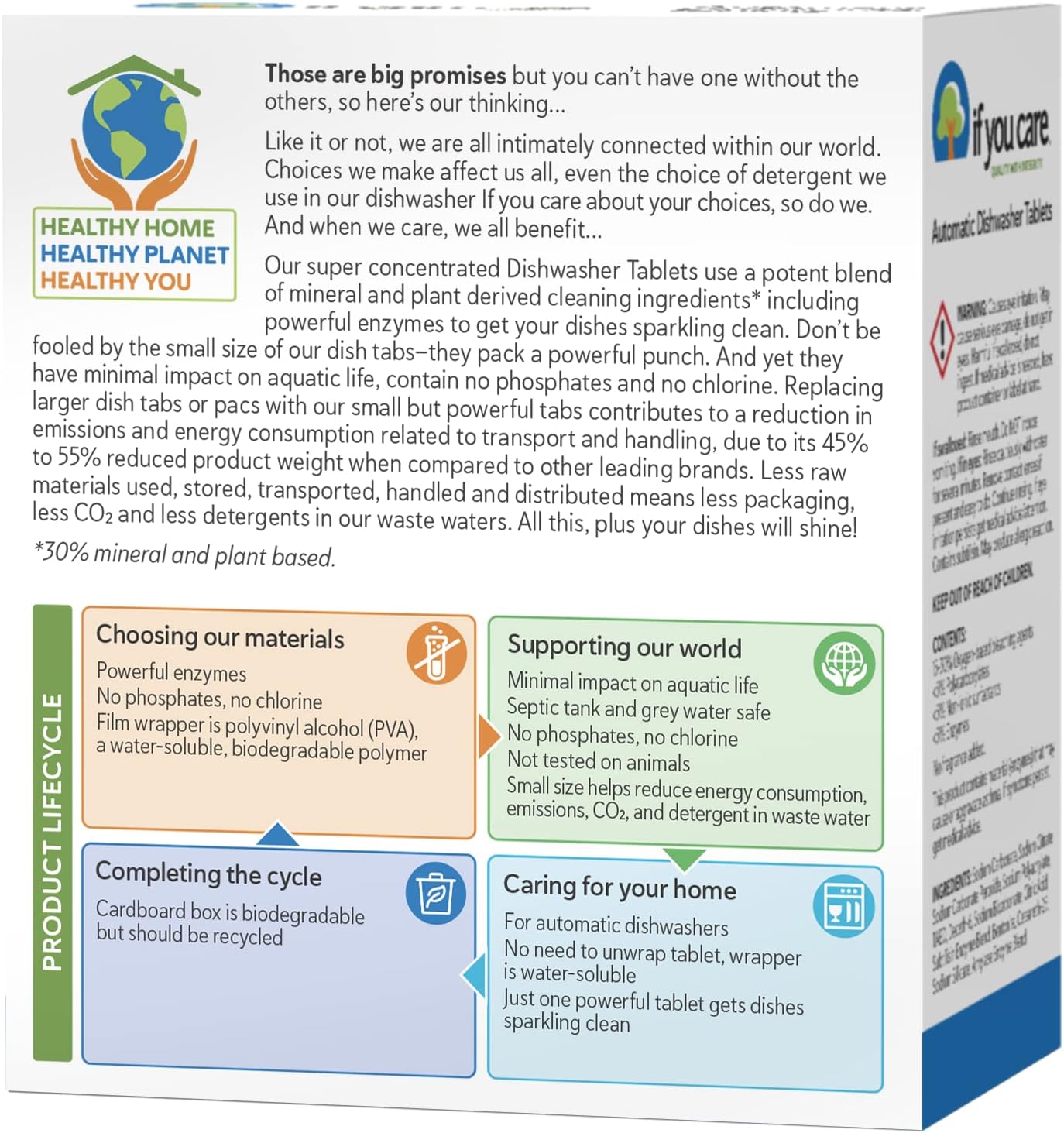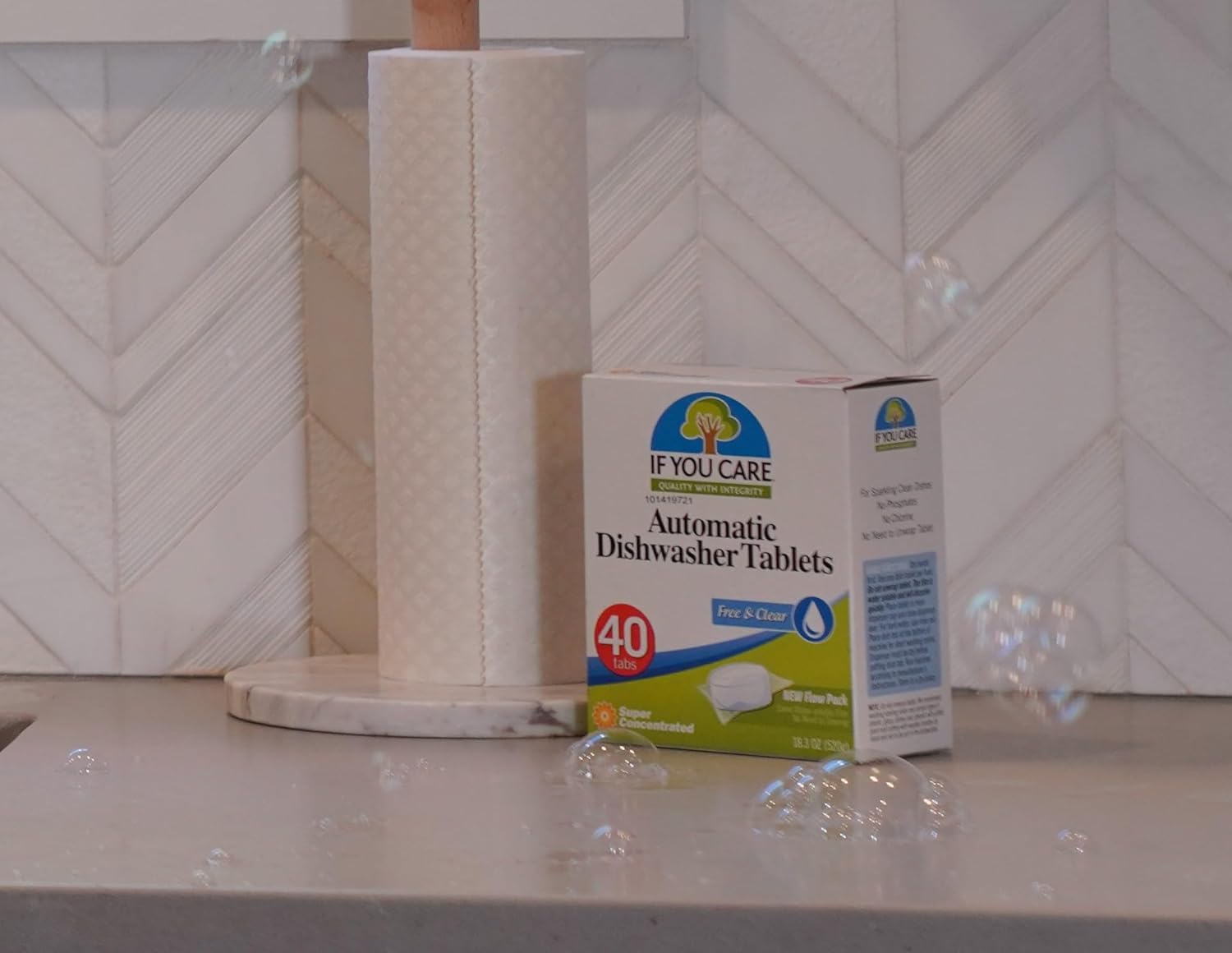



If You Care Dishwasher Tablets - Potent Plant-Based Cleaner, Non-Toxic, 40 Count


Sodium Carbonate Peroxide
High RiskSodium carbonate peroxide is an inorganic salt commonly used as a bleaching agent and oxidizer in various cleaning and laundry products.
Sustai Insights
Sodium carbonate peroxide serves effectively as a bleaching and cleaning agent, contributing to product efficacy. However, it poses health risks such as skin and eye irritation, with regulatory restrictions on use due to its potential hazards. Its environmental impact may include being a pollutant, while it is not classified as a bioaccumulative agent. Overall, the risk level associated with sodium carbonate peroxide is high, necessitating careful usage and consideration of safer alternatives.
Citric Acid
Medium RiskCitric acid is an alpha hydroxy acid used in personal care products primarily for its role as a pH adjuster and natural preservative. It occurs naturally in citrus fruits and is commonly utilized in various formulations for its chelating properties and mild exfoliation benefits.
Sustai Insights
Citric acid offers functional benefits as an effective preservative and pH stabilizer, contributing to product longevity and stability. It is biodegradable and derived from renewable sources. Health risks are low, with minimal concerns regarding carcinogenicity, allergies, and reproductive toxicity. However, moderate use restrictions exist due to potential irritation at high concentrations. Environmental risks are limited, as citric acid is not known to accumulate in ecosystems. Regulatory agencies have no significant advisories against its use. Overall, it is assessed as a medium-risk ingredient, with safe usage practices recommended and alternatives available.
Sodium Silicate
Medium RiskSodium silicate is a sodium salt of silicic acid, commonly used in various products for its adhesive and binding properties. It serves multiple functions, including as a pH regulator and a stabilizing agent in formulations.
Sustai Insights
Sodium silicate offers functional benefits such as effective binding and stabilization in formulations. Its health risks are considered moderate, primarily concerning potential skin irritation and allergenic reactions, while its environmental impact is low, with no significant pollutant or bioaccumulation concerns. Regulatory bodies indicate low use restrictions. Recommended safe usage practices include avoiding direct skin contact. Alternatives, such as natural binders, may offer safer options. Overall, sodium silicate presents a medium risk assessment.
Bentonite
Medium RiskBentonite is a native hydrated colloidal aluminum silicate clay that is utilized in various products for its binding, thickening, and absorbent properties. It serves functions such as stabilizing emulsions and enhancing texture in formulations.
Sustai Insights
Bentonite offers functional benefits as a thickening agent and stabilizer, and it is often sourced sustainably. It has low concerns for carcinogenicity, allergies, and developmental toxicity, but moderate use restrictions exist. Environmental risks include potential pollutant characteristics. Regulatory bodies have noted these restrictions, suggesting careful usage. Overall, the risk level is assessed as medium, and users are advised to consider alternatives like kaolin clay for similar properties.
Bornanedione
Low RiskBornanedione is an organic compound that serves various functions in products, primarily in the realm of fragrance and flavoring agents. Its use is regulated, and it is not currently listed among restricted substances in skin contact applications, suggesting a generally accepted safety profile.
Sustai Insights
Bornanedione offers functional benefits as a flavoring agent without significant health risks, including low concerns for carcinogenicity, allergenicity, and reproductive toxicity. Environmentally, it poses minimal risks, with no evidence of bioaccumulation or pollution. Regulatory bodies do not impose notable restrictions. Overall, the ingredient presents a low risk profile, making it a safe choice in formulations.
Sodium Bicarbonate
Low RiskSodium bicarbonate, commonly known as baking soda, is an inorganic compound with the formula NaHCO₃. It functions primarily as a leavening agent in baking, helping to produce carbon dioxide gas when it reacts with acids, thereby causing dough to rise. It also serves as a mild alkaline agent in various personal care products.
Sustai Insights
Sodium bicarbonate is valued for its effectiveness as a leavening agent and its role in neutralizing acidity, contributing to product stability. It is considered environmentally friendly and biodegradable. Health risks are minimal, with low concerns regarding carcinogenicity, allergies, and reproductive toxicity. It is not classified as a pollutant and poses no significant environmental hazards. Regulatory assessments indicate it is safe for use in food and cosmetic products. Overall, sodium bicarbonate carries a low risk, making it a practical choice in many applications.
Glycol Cetearate
Low RiskGlycol cetearate is an ester of ethylene glycol and cetyl alcohol, commonly used as an emulsifier in cosmetic and personal care products. It helps to stabilize formulations by blending oil and water components, enhancing texture and consistency.
Sustai Insights
Glycol cetearate offers functional benefits as an effective emulsifier, improving product stability and user experience. It is generally considered safe with low risks of carcinogenicity, allergies, and developmental toxicity. Environmental assessments indicate it poses minimal ecological threats, with no significant bioaccumulation potential. Regulatory bodies currently do not impose restrictions. Therefore, the overall risk level is assessed as low, making it a suitable choice in formulation. For those seeking alternatives, other emulsifiers like sucrose stearate may provide similar benefits.
Amylase
Low RiskAmylase is an enzyme that catalyzes the breakdown of starches into sugars. It is commonly used in food processing, detergents, and other industrial applications to enhance product functionality. Its effectiveness depends on specific conditions, such as temperature and pH, making it versatile in applications ranging from baking to stain removal.
Sustai Insights
Amylase offers functional benefits by efficiently breaking down starches, enhancing food texture and cleaning performance. It is widely recognized as safe and biodegradable, aligning with sustainability goals. However, exposure may pose irritation risks for individuals with enzyme allergies, particularly through inhalation or skin contact. Regulatory assessments classify amylase as generally safe, with no carcinogenic or endocrine-disrupting properties reported. Environmental risks are minimal due to its natural degradability, and its use in products typically adheres to stringent safety standards. While alternative enzymes exist, amylase remains a preferred choice due to its efficiency and low overall risk, which is considered manageable with appropriate precautions.
Sodium Polyacrylate
Low RiskSodium polyacrylate is a sodium salt of polyacrylic acid, commonly used as a thickener, absorbent, or gelling agent in various personal care and household products. It is known for its ability to retain moisture and improve product texture.
Sustai Insights
Sodium polyacrylate offers functional benefits such as moisture retention and texture improvement in formulations. It is considered to have low health risks, with negligible concerns regarding carcinogenicity, allergies, or reproductive toxicity. Environmentally, it poses minimal risk as a pollutant and is not bioaccumulative. Regulatory bodies impose few restrictions, indicating its safety profile. Overall, it is regarded as low risk, making it a viable option in formulation practices.
Sodium Citrate
Low RiskSodium citrate is used in cosmetic formulations primarily as a buffering agent, helping to stabilize pH levels. It is derived from citric acid and is commonly found in various personal care products to enhance their efficacy and stability.
Sustai Insights
Sodium citrate offers functional benefits such as effective pH regulation and acts as a mild preservative. It is generally recognized as safe with low risks for cancer, allergies, and reproductive toxicity. Environmental concerns are minimal, with no significant pollutant potential or bioaccumulation. Regulatory bodies like the FDA and COSMOS have no major restrictions on its use. Overall, sodium citrate presents a low risk, making it a viable ingredient in cosmetic formulations. Safe usage practices should be followed, and alternatives are not typically necessary.
Sodium Carbonate Peroxide
High RiskSodium carbonate peroxide is an inorganic salt commonly used as a bleaching agent and oxidizer in various cleaning and laundry products.
Sustai Insights
Sodium carbonate peroxide serves effectively as a bleaching and cleaning agent, contributing to product efficacy. However, it poses health risks such as skin and eye irritation, with regulatory restrictions on use due to its potential hazards. Its environmental impact may include being a pollutant, while it is not classified as a bioaccumulative agent. Overall, the risk level associated with sodium carbonate peroxide is high, necessitating careful usage and consideration of safer alternatives.
Citric Acid
Medium RiskCitric acid is an alpha hydroxy acid used in personal care products primarily for its role as a pH adjuster and natural preservative. It occurs naturally in citrus fruits and is commonly utilized in various formulations for its chelating properties and mild exfoliation benefits.
Sustai Insights
Citric acid offers functional benefits as an effective preservative and pH stabilizer, contributing to product longevity and stability. It is biodegradable and derived from renewable sources. Health risks are low, with minimal concerns regarding carcinogenicity, allergies, and reproductive toxicity. However, moderate use restrictions exist due to potential irritation at high concentrations. Environmental risks are limited, as citric acid is not known to accumulate in ecosystems. Regulatory agencies have no significant advisories against its use. Overall, it is assessed as a medium-risk ingredient, with safe usage practices recommended and alternatives available.
Bornanedione
Low RiskBornanedione is an organic compound that serves various functions in products, primarily in the realm of fragrance and flavoring agents. Its use is regulated, and it is not currently listed among restricted substances in skin contact applications, suggesting a generally accepted safety profile.
Sustai Insights
Bornanedione offers functional benefits as a flavoring agent without significant health risks, including low concerns for carcinogenicity, allergenicity, and reproductive toxicity. Environmentally, it poses minimal risks, with no evidence of bioaccumulation or pollution. Regulatory bodies do not impose notable restrictions. Overall, the ingredient presents a low risk profile, making it a safe choice in formulations.
Sodium Silicate
Medium RiskSodium silicate is a sodium salt of silicic acid, commonly used in various products for its adhesive and binding properties. It serves multiple functions, including as a pH regulator and a stabilizing agent in formulations.
Sustai Insights
Sodium silicate offers functional benefits such as effective binding and stabilization in formulations. Its health risks are considered moderate, primarily concerning potential skin irritation and allergenic reactions, while its environmental impact is low, with no significant pollutant or bioaccumulation concerns. Regulatory bodies indicate low use restrictions. Recommended safe usage practices include avoiding direct skin contact. Alternatives, such as natural binders, may offer safer options. Overall, sodium silicate presents a medium risk assessment.
Bentonite
Medium RiskBentonite is a native hydrated colloidal aluminum silicate clay that is utilized in various products for its binding, thickening, and absorbent properties. It serves functions such as stabilizing emulsions and enhancing texture in formulations.
Sustai Insights
Bentonite offers functional benefits as a thickening agent and stabilizer, and it is often sourced sustainably. It has low concerns for carcinogenicity, allergies, and developmental toxicity, but moderate use restrictions exist. Environmental risks include potential pollutant characteristics. Regulatory bodies have noted these restrictions, suggesting careful usage. Overall, the risk level is assessed as medium, and users are advised to consider alternatives like kaolin clay for similar properties.
Sodium Bicarbonate
Low RiskSodium bicarbonate, commonly known as baking soda, is an inorganic compound with the formula NaHCO₃. It functions primarily as a leavening agent in baking, helping to produce carbon dioxide gas when it reacts with acids, thereby causing dough to rise. It also serves as a mild alkaline agent in various personal care products.
Sustai Insights
Sodium bicarbonate is valued for its effectiveness as a leavening agent and its role in neutralizing acidity, contributing to product stability. It is considered environmentally friendly and biodegradable. Health risks are minimal, with low concerns regarding carcinogenicity, allergies, and reproductive toxicity. It is not classified as a pollutant and poses no significant environmental hazards. Regulatory assessments indicate it is safe for use in food and cosmetic products. Overall, sodium bicarbonate carries a low risk, making it a practical choice in many applications.
Glycol Cetearate
Low RiskGlycol cetearate is an ester of ethylene glycol and cetyl alcohol, commonly used as an emulsifier in cosmetic and personal care products. It helps to stabilize formulations by blending oil and water components, enhancing texture and consistency.
Sustai Insights
Glycol cetearate offers functional benefits as an effective emulsifier, improving product stability and user experience. It is generally considered safe with low risks of carcinogenicity, allergies, and developmental toxicity. Environmental assessments indicate it poses minimal ecological threats, with no significant bioaccumulation potential. Regulatory bodies currently do not impose restrictions. Therefore, the overall risk level is assessed as low, making it a suitable choice in formulation. For those seeking alternatives, other emulsifiers like sucrose stearate may provide similar benefits.
Amylase
Low RiskAmylase is an enzyme that catalyzes the breakdown of starches into sugars. It is commonly used in food processing, detergents, and other industrial applications to enhance product functionality. Its effectiveness depends on specific conditions, such as temperature and pH, making it versatile in applications ranging from baking to stain removal.
Sustai Insights
Amylase offers functional benefits by efficiently breaking down starches, enhancing food texture and cleaning performance. It is widely recognized as safe and biodegradable, aligning with sustainability goals. However, exposure may pose irritation risks for individuals with enzyme allergies, particularly through inhalation or skin contact. Regulatory assessments classify amylase as generally safe, with no carcinogenic or endocrine-disrupting properties reported. Environmental risks are minimal due to its natural degradability, and its use in products typically adheres to stringent safety standards. While alternative enzymes exist, amylase remains a preferred choice due to its efficiency and low overall risk, which is considered manageable with appropriate precautions.
Sodium Polyacrylate
Low RiskSodium polyacrylate is a sodium salt of polyacrylic acid, commonly used as a thickener, absorbent, or gelling agent in various personal care and household products. It is known for its ability to retain moisture and improve product texture.
Sustai Insights
Sodium polyacrylate offers functional benefits such as moisture retention and texture improvement in formulations. It is considered to have low health risks, with negligible concerns regarding carcinogenicity, allergies, or reproductive toxicity. Environmentally, it poses minimal risk as a pollutant and is not bioaccumulative. Regulatory bodies impose few restrictions, indicating its safety profile. Overall, it is regarded as low risk, making it a viable option in formulation practices.
Sodium Citrate
Low RiskSodium citrate is used in cosmetic formulations primarily as a buffering agent, helping to stabilize pH levels. It is derived from citric acid and is commonly found in various personal care products to enhance their efficacy and stability.
Sustai Insights
Sodium citrate offers functional benefits such as effective pH regulation and acts as a mild preservative. It is generally recognized as safe with low risks for cancer, allergies, and reproductive toxicity. Environmental concerns are minimal, with no significant pollutant potential or bioaccumulation. Regulatory bodies like the FDA and COSMOS have no major restrictions on its use. Overall, sodium citrate presents a low risk, making it a viable ingredient in cosmetic formulations. Safe usage practices should be followed, and alternatives are not typically necessary.
Discover the eco-friendly power of If You Care Dishwasher Tablets, designed for those who prioritize sustainability without compromising on cleanliness. Each tablet is super concentrated, making dishwashing efficient and effective, while also being gentle on the planet.
- Potent Cleaning Power: These tablets harness a blend of mineral and plant-derived ingredients, such as coconut and rapeseed, ensuring your dishes shine without harsh chemicals.
- Eco-Conscious Choice: Free from phosphates and chlorine, these biodegradable tablets dissolve quickly, minimizing impact on aquatic life and promoting a healthier ecosystem.
- Compact Convenience: Replace bulky pods and liquids with our small, powerful tablets that cut down on emissions and energy costs associated with transport.
- Lightweight Design: Weighing 45-55% less than leading brands, these tablets reduce raw material usage and carbon footprint, contributing to a greener future.
- Quality with Integrity: Committed to sustainability, If You Care products are crafted for minimal environmental impact while delivering exceptional cleaning performance.
Subscribe & Save with Sustai
- Best Price Guarantee: Always enjoy the lowest prices on sustainable home essentials.
- No Surprises: We’ll notify you before shipping. No hidden fees, ever.
- You’re in Charge: Change, pause, or cancel your subscription anytime with ease.
- Eco-Friendly Deliveries: Our grouped shipments mean less packaging and lower emissions.
Join us on a sustainable journey. Special offers for a limited time! Prices and promotions may change.
Recommended Products
Discover the eco-friendly power of If You Care Dishwasher Tablets, designed for those who prioritize sustainability without compromising on cleanliness. Each tablet is super concentrated, making dishwashing efficient and effective, while also being gentle on the planet.
- Potent Cleaning Power: These tablets harness a blend of mineral and plant-derived ingredients, such as coconut and rapeseed, ensuring your dishes shine without harsh chemicals.
- Eco-Conscious Choice: Free from phosphates and chlorine, these biodegradable tablets dissolve quickly, minimizing impact on aquatic life and promoting a healthier ecosystem.
- Compact Convenience: Replace bulky pods and liquids with our small, powerful tablets that cut down on emissions and energy costs associated with transport.
- Lightweight Design: Weighing 45-55% less than leading brands, these tablets reduce raw material usage and carbon footprint, contributing to a greener future.
- Quality with Integrity: Committed to sustainability, If You Care products are crafted for minimal environmental impact while delivering exceptional cleaning performance.

You can have at most 2 Sustainable Steals products in your cart
Customer Reviews
Customers’ View
Customers appreciate the effectiveness and eco-friendly nature of the Dishwasher Tablets, highlighting their powerful cleaning capabilities and pleasant scent. Many users note that the plant-based ingredients and biodegradable packaging align well with their values as environmentally-conscious consumers. Positive remarks include, "Dishes come out clean and they don't smell like cleaning products," emphasizing the product's ability to tackle tough stains, including dried-on food. However, some customers report issues with tablets not dissolving completely, leaving residue on dishes, and mixed opinions about value for money. Despite these concerns, many find the product to be a solid choice for sustainable dishwashing. Overall, customers feel this product effectively balances cleaning performance with environmental responsibility.
AI-generated from the text of customer reviewsThis product has no reviews yet.




